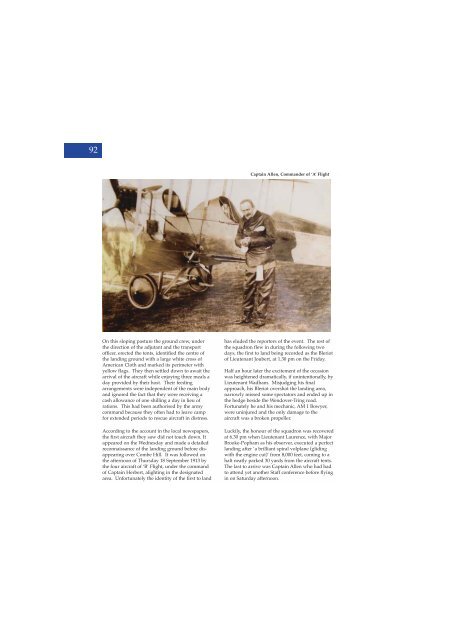Volume 6 No 4 - Royal Air Force Centre for Air Power Studies
Volume 6 No 4 - Royal Air Force Centre for Air Power Studies
Volume 6 No 4 - Royal Air Force Centre for Air Power Studies
You also want an ePaper? Increase the reach of your titles
YUMPU automatically turns print PDFs into web optimized ePapers that Google loves.
92<br />
Captain Allen, Commander of ‘A’ Flight<br />
On this sloping pasture the ground crew, under<br />
the direction of the adjutant and the transport<br />
officer, erected the tents, identified the centre of<br />
the landing ground with a large white cross of<br />
American Cloth and marked its perimeter with<br />
yellow flags. They then settled down to await the<br />
arrival of the aircraft while enjoying three meals a<br />
day provided by their host. Their feeding<br />
arrangements were independent of the main body<br />
and ignored the fact that they were receiving a<br />
cash allowance of one shilling a day in lieu of<br />
rations. This had been authorised by the army<br />
command because they often had to leave camp<br />
<strong>for</strong> extended periods to rescue aircraft in distress.<br />
According to the account in the local newspapers,<br />
the first aircraft they saw did not touch down. It<br />
appeared on the Wednesday and made a detailed<br />
reconnaissance of the landing ground be<strong>for</strong>e disappearing<br />
over Combe Hill. It was followed on<br />
the afternoon of Thursday 18 September 1913 by<br />
the four aircraft of ‘B’ Flight, under the command<br />
of Captain Herbert, alighting in the designated<br />
area. Un<strong>for</strong>tunately the identity of the first to land<br />
has eluded the reporters of the event. The rest of<br />
the squadron flew in during the following two<br />
days, the first to land being recorded as the Bleriot<br />
of Lieutenant Joubert, at 1.30 pm on the Friday.<br />
Half an hour later the excitement of the occasion<br />
was heightened dramatically, if unintentionally, by<br />
Lieutenant Wadham. Misjudging his final<br />
approach, his Bleriot overshot the landing area,<br />
narrowly missed some spectators and ended up in<br />
the hedge beside the Wendover-Tring road.<br />
Fortunately he and his mechanic, AM 1 Bowyer,<br />
were uninjured and the only damage to the<br />
aircraft was a broken propeller.<br />
Luckily, the honour of the squadron was recovered<br />
at 6.30 pm when Lieutenant Laurence, with Major<br />
Brooke-Popham as his observer, executed a perfect<br />
landing after ‘a brilliant spiral volplane (gliding<br />
with the engine cut)’ from 8,000 feet, coming to a<br />
halt neatly parked 30 yards from the aircraft tents.<br />
The last to arrive was Captain Allen who had had<br />
to attend yet another Staff conference be<strong>for</strong>e flying<br />
in on Saturday afternoon.
















